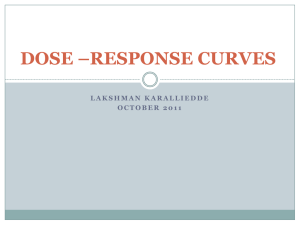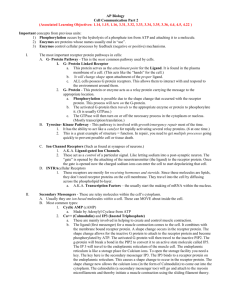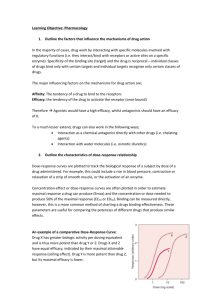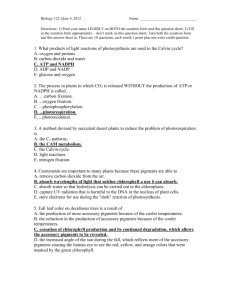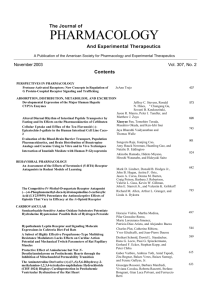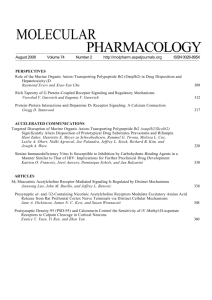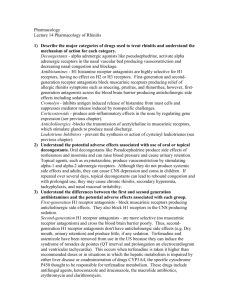Drug-Receptor Interaction Simple Occupancy Theory
advertisement
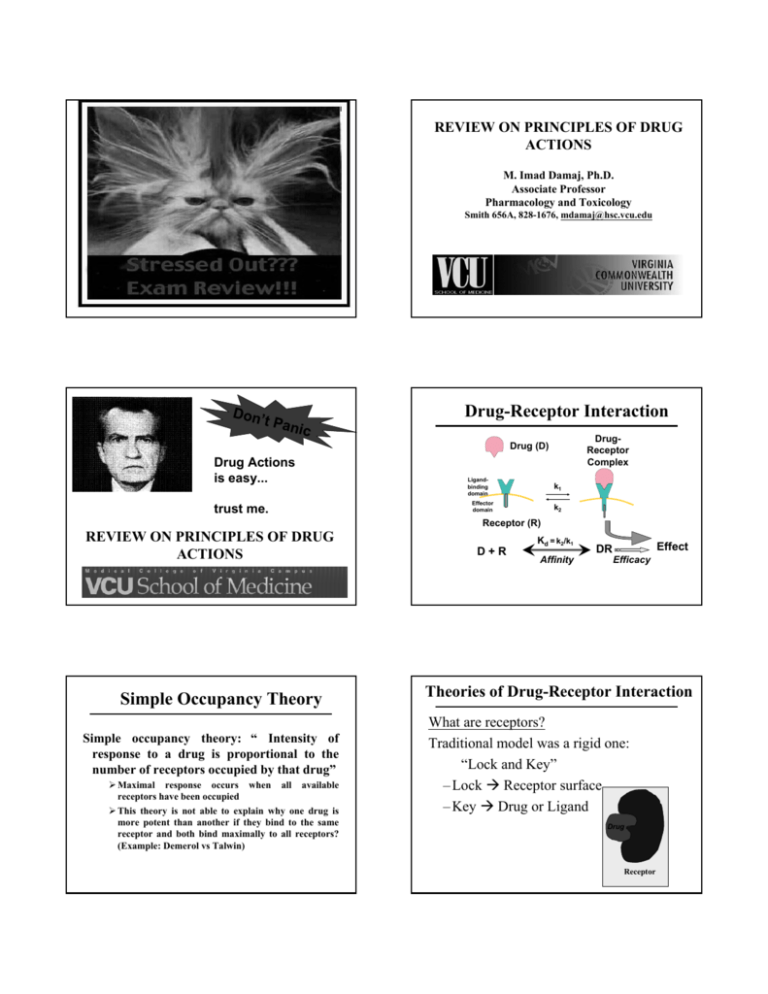
REVIEW ON PRINCIPLES OF DRUG ACTIONS M. Imad Damaj, Ph.D. Associate Professor Pharmacology and Toxicology Smith 656A, 828-1676, mdamaj@hsc.vcu.edu Don’ t Pan Drug-Receptor Interaction ic DrugDrugReceptor Complex Drug (D) Drug Actions is easy... trust me. LigandLigandbinding domain k1 Effector domain k2 Receptor (R) REVIEW ON PRINCIPLES OF DRUG ACTIONS Simple Occupancy Theory Simple occupancy theory: theory “ Intensity of response to a drug is proportional to the number of receptors occupied by that drug” ¾ Maximal response occurs when all available receptors have been occupied ¾ This theory is not able to explain why one drug is more potent than another if they bind to the same receptor and both bind maximally to all receptors? (Example: Demerol vs Talwin) D+R Kd = k2/k1 Affinity Effect DR Efficacy Theories of Drug-Receptor Interaction What are receptors? Traditional model was a rigid one: “Lock and Key” – Lock Æ Receptor surface – Key Æ Drug or Ligand Drug Receptor Theories of Drug-Receptor Interaction ¾ ¾ ¾ ¾ HOW TO EXPLAIN EFFICACY? Drug (D) Receptors Æ fluid, flexible surfaces or pockets Can change 3-D structure as ligand docks Occupy small portion or surface of a macromolecule Ligand - Receptor docking Æ structure changes Inactive Ri Ra DRi DRa The relative affinity Of the drug to either conformation will determine the effect of the drug Active CONFORMATIONAL SELECTION Main Receptor Classes SPARE RECEPTORS ¾The receptor theory assumes that all receptors should be occupied to produce a maximal response. In that case at half maximal effect EC50=Kd. Sometimes, full effect is seen at a fractional receptor occupation Spare receptors ¾Allow maximal response without total receptor occupancy – increase sensitivity of the system ¾ The number of receptors may exceed the number of effector-molecules available ¾Receptor remains activated after agonist departs: more than one receptor is activated Maximum Effect or Efficacy Slope To determine the quantitative relation between drug concentration and response Characteristics of A Dose-Response Curve Effect DOSE-RESPONSE RELATIONSHIPS Variability Potency (EC50) Log Dose Types of Dose-Response Curves: Graded 100 Potency: Quantal Responses 100 Relaxation 80 ED90 = 490 mg 80 % 60 Achieving Complete Analgesia 40 60 % Control PDE Inhibition 40 Graded: Dose related to magnitude on a graded scale 20 0 1 10 100 20 0 100 1000 Theophylline [µM] ED50 = 400 mg Total Lidocaine Dose (mg) 1000 Ferrante et al. Anesth Analg 82:9182:91-7, 1996 Dose-Response Curves and Efficacy Relative Safety of A Drug ¾ Dose-response curves help estimating the safety of a drug ¾ Therapeutic Index: TI= LD50/ED50 * LD50= the median lethal dose of a drug in animals * Statement on selectivity of desired effects vs toxic Antagonist Effects on Dose-Response Curves Comparison of Dose-Response Curves A) Competitive Antagonists A C Effect B A (Lethality) Potency A>B>C B Efficacy A=C>B Safety ( T.I.) A>B Antagonist Effects on Dose-Response Curves B) Non-Competitive Antagonists FACTORS MODIFYING DRUG DOSE-RESPONSE RELATIONSHIP Predictable Influencing Factors Drugs and Age of Patients BODY SIZE AGE GENDER ROUTE OF ADMINISTRATION TIME OF ADMINISTRATION PATHOLOGICAL STATE TOLERANCE GENETIC FACTORS PRESENCE OF OTHER DRUGS Changes in Body Proportions with Age Age-Dependent of Diazepam Elimination PATHOLOGICAL STATE & DRUGS PATHOLOGICAL STATE & DRUGS • Pathophysiology: how disease affects responses to drugs • Kidney Effect of Renal Failure on Kanamycin T1/2 Effect of liver cirrhosis on propranolol levels –Reduce drug excretion: drugs accumulate in body –Must decrease dosage of drug until kidney function back to normal • Liver –Site of drug detoxification and metabolism –Drug will accumulate to toxic levels in body Drugs and Fetal Development Drug Therapy During Pregnancy and Breastfeeding •Physiological changes in pregnancy that impact drug dosing are in the: –Kidney –Liver –Gastrointestinal tract •All drugs cross the placenta •Drug transfer is –Easier—lipid soluble drugs –Difficult—ionized, highly polar or protein-bound drugs Moore, 1993. Food & Drug Effects GENETIC POLYMORPHISMS Pharmacokinetic •Transporters •Plasma protein binding •Metabolism Pharmacodynamic •Receptors •Ion channels •Enzymes •Immune molecules Atypical Plasma Cholinesterase •Atypical plasma cholinesterase has 1/100 the affinity for succinylcholine as normal enzyme •occurs in 1:2500 individuals % Inhibition Typical 100 80 60 40 20 0 Atypical normal enzyme inhibited > 70% abnormal inhibited < 30% -6 -4 ETHNIC DIFFERENCES IN THE DISTRIBUTION OF ACETYLATOR PHENOTYPE % Slow % Hetero Fast South Indians Caucasians Blacks Population 59 58.6 54.6 35.6 35.9 38.6 % Homo Fast 5.4 5.5 6.8 Eskimos Japanese Chinese 10.5 12 22 43.8 45.3 49.8 45.7 42.7 28.2 From: Kalo W. Clin Pharmacokinet 7:373-4000, 1982. log molar dibucaine conc. Adapted from: Pharmac Ther 47:35-60, 1990. Preclinical Safety and Toxicology Testing (LD50) Clinical Trials: Main Questions ¾ ¾ ¾ Phase I – What are the side effects? – Is it safe enough to test? Phase II – Does it work at all? – What is the dosage range? Phase III – Is it better than placebo? – Is it better than other treatments? – What are the side-effects Problem Which drug would you choose to send to Phase I trials based on the following preclinical data: 1. Drug A: TI = 100 - T1/2 = 10 min in rodents 2. Drug B: TI = 10 - T1/2 = 90 min in rodents 3. Drug C: TI = 90 - T1/2 = 2 min & Rapidly metabolized to OH-C Laws Regulating Manner of Drugs Dispensing Schedules z 9 The Durham-Humphrey Amendment of 1952 – Establish “legend” drugs: “Caution: Federal laws prohibits dispensing without prescription” z – Prescriptions refill – Recognized the OTC drugs 9 Controlled Substances Act in 1970 z z – Classified controlled substances into schedules (flexible) z – requires that prescribers and dispensers register with the Drug Enforcement Agency (DEA) z Schedule I: Highest abuse potential, no medical use in the U.S. Schedule II: High abuse potential, but, may be used medicinally Schedule III: Limited dependance potential Schedule IV: Lower abuse potential than I & II Schedule V: Lowest potential for abuse Schedule VI (Virginia): all legend drugs not included in other schedules
